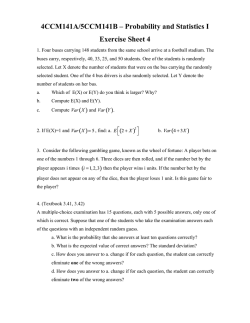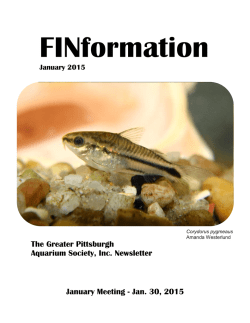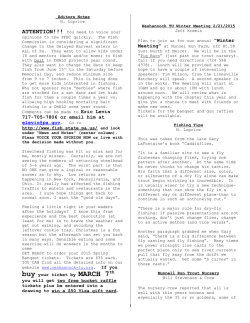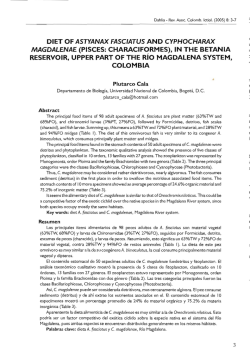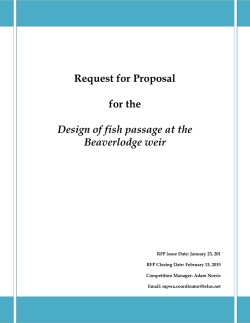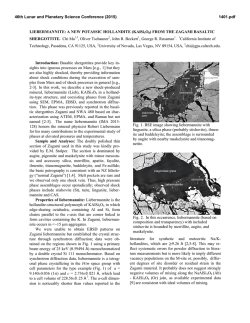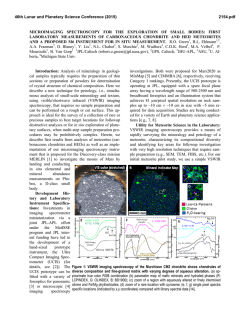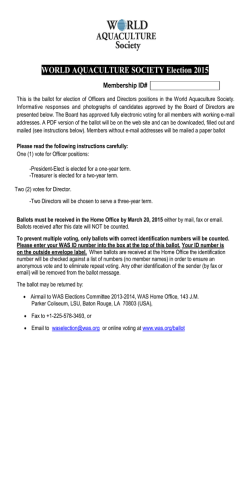
0 Tips on Tuna Handling - Woods Hole Oceanographic Institution
0 Tips on Tuna Handling courtesy of the 1930 Sea Grant Program Woods Hole Oceanographic Institution Sea Grant Program Woods Hole, MA 02543 Introduction. Bluefin tuna are worth a lot of money if they are handled properly. The value of this fishery is driven largely by the high demand for top-quality, fresh tuna for the Japanese market. Fresh bluefin tuna is most valuable when the fat content is high (generally between the end of July and October) and when the fish has been handled properly to maintain its freshness and appearance. You would probably be astonished to see how particular the Japanese are about the freshness and quality of tuna for the raw fish (sashimi and sushi) market. But if you have an opportunity to try really fresh tuna sashimi (maguro), you'll soon realize why it's worth all the fuss. It may be difficult, if not impossible, for you to do all the handling operations suggested below, because of your boat size, sea conditions, lack of crew, etc. At least, try to keep mechanical damage of the fish to a minimum, bleed It immediately, keep It cool and moist, and get it to a buyer as soon as possible. It's a good idea to check with tuna buyers in your area because their preferred handling techniques may vary somewhat from those presented here. Important Points. The aim of much of the handling procedure is to cool the fish quickly. Tuna keep their body temperature higher than the water temperature, plus they heat up during the struggle when hooked. It can take a long time to lower the internal temperature of a tuna, especially a large one. The chances of tainting and spoilage (either "burnt tuna syndrome" or histamine production, which can lead to scombroid poisoning) are reduced if the body temperature is lowered as soon as possible. This is why rapid removal of the blood and guts, which are warm, is important. In addition, removal of the blood and guts reduces sources of chemical and microbial contamination of the fish flesh. Do not move or touch the fish any more than necessary because the flesh bruises easily and will develop soft spots. Use of rubber gloves will avoid heat and oil from hands, which can discolor flesh. Use a clean knife. Keep fish wet and out of direct sun. Tuna buyers are easily able to recognize when fish have been improperly handled. Landing. For a giant bluefin tuna, this may be a tough job. Gaff the fish in the head region, through the lower jaw if possible. Hoist it aboard, trying not to bang fish on side rail. Treat side of fish that was pulled in over rail as the "bad side." Lay fish on its bad side on a smooth, padded (foam, blanket, rubber, etc.) deck surface away from hot deck plate and engine heat, being careful not to damage the fish on sharp objects or angles. If fish is too large to be landed, hoist it by the tail and make bleeding cuts in tail (see below) and rake the gills. Tow it alongside the boat, head first if possible, in a way that will keep the fish from banging against the boat and so there is no "bow" in the fish which can cause tissue damage to the flesh. Get the fish to a buyer as soon as possible. Check your radio for tuna buyboats in the area. Stunning. Immediately stun the fish with a hard blow (club, bat, mallet, rubber hammer, etc.) to the soft spot between the eyes. Obviously a large fish cannot be "ba. bied" in this regard. Do your best, keeping your safety first. Immobilize the fish by deadening the brain and nerves. Push a sharp metal spike (ice pick, screwdriver) into the brain, which lies under the soft spot between the eyes, and twist it around to destroy nerve tissue. Bleeding. Tuna should be bled as soon as possible to reduce internal temperature and to develop desirable color contrast of the flesh. Do not disturb the heart, as its beating will help pump blood out of the fish. Lift the pectoral fin and about one hand width behind its base make a vertical stab cut 1 to 2 inches long and 1 to 2 inches deep to cut the large artery in the mid-line of the fish (Fig. 1 ). Make a shallow cut across each side of the fish in the tail region between the 3rd and 4th dorsal fin lets (Fig. 1 ). Cuts should only be deep enough to sever the main artery located just under the skin in the mid-line of the fish. Keep the fish wet so the blood flows freely. Bleeding requires about 5 minutes. Gutting and G/11/ng. Guts should be removed as quickly as possible, particularly from large tuna, to reduce internal temperature. Make a straight, 4-inch long slit in the belly, cutting toward the anus, just deep enough to open the belly cavity (Fig. 2). Do not cut through the anus so as to minimize exposure of flesh to digestive acids and bac- teria. Reach into belly cavity and pull out the 3 "chords" (intestine plus 2 gonads) and cut them off near the anus, so contents do not spill in gut cavity (Fig. 3). Guts can sometimes be removed fairly easily at this stage if you have a deck hose with good water pressure. Place the hose in the belly slit. The water pressure will often force the guts out the fish's mouth. If so, cut the guts away. If this fails, the guts must be removed through the gill opening after removing the gills. The flow of water inside helps to cool the fish and minimizes staining of the valuable belly flesh from digestive juices. Lift gill cover and make a cut at top of gill cover toward the eye (Fig. 4). Pull the cover back and cut the muscle attaching the gill cover to the head (Fig. 5). Then cut lower end of the gill arch connections, but do not cut through the throat area as this will lead to distortion of the head area at rigor mortis (Fig. 6). Cut around the gill membranes behind the gills up and down the length of the gill opening (Fig. 7). Be sure to leave the crescent-shaped bone behind the gill area intact. Insert knife under gills, close to spine, and cut upper end of gill-to-head attachment (Fig. 8). Perform same steps to remove gills from other side. Grab gills and remove them and the guts with a firm pull (Fig. 9). Remove remaining guts, stripping membranes which attach gonads to body wall. Remove as much of the dark kidney along the backbone as possible. Scrub backbone with a stiff brush until white and flush with plenty of water to get rid of coagulated blood and slime (Fig. 10). Remove the membrane surrounding the gill collar and remove all loose skin from gill exit (Fig. 11 ). Gently clean slime from outside of fish. The entire cleaning process takes about 15 minutes for an experienced person. Chilling. If boat is equipped with a chill tank, submerge bled, gutted and gil led fish for 1 hour in an ice-seawater slurry made with 2 parts ice to 1 part seawater. Then remove fish and pack it with ice. If you do not have a chill tank, pack body cavity with bags of ice immediately after cleaning. Cover fish with sheet of plastic and, if possible, completely ice fish over. Ice directly on the skin will cause blotching. If you do not have ice, keep the fish wet and out of the sun. 0 Tips on Tuna Handling courtesy of the Woods Hole Oceanographic Institution Sea Grant Program Woods Hole, MA 02543 Sea Grant Program position of stab cut 1 to 2 inches deep 1 3 ~ ~ Anus ··foi~=- ~ fin recess pectoral fin pulled forward Insert knife 4" in front of the anus, and then cut toward it. Cut the intestine near the anus. 4 Lower End of Attachment Insert knife at the top of the gill cover and slide It toward the eye. Cut the main muscle attaching the gill cover to the head. Cut lower end of gill-to-head attachment. 7 Cut through the membrane behind the gills. Cut upper end of gill-to-head attachment. Remove gills & guts and any remaining attachments. 11 Scrub spine through gill openings to remove the kidney. Trim the membranes lining the gill collar. Acknowledgement. The Woods Hole Oceanographic Institution Sea Grant Program supports research, education and advisory projects aimed at promoting understanding and wise use of marine and coastal resources. This information sheet was prepared with funds from the NOAA National Sea Grant College Program Office, Department of Commerce, under Grant No. NA86-AA-D-SG090 to the Woods Hole Oceanographic Institution, WHOI Sea Grant Project No. M!0-2 and AIS-8-PD. Fig. 1 was taken with permission of New York Sea Grant from "Tuna Handling Tips" by C. Smith and R. Groh, 1983. Figs. 2-11 were taken with permission of Hawaii Sea Grant from "The Management of Yellowfin Tuna in the Handline Fishing Industry of Hawaii: A Fish-Handling Handbook" by R. Nakamura, J. Akamine, D. Coleman, and S. Takashima, 1987. WHOI Sea Grant would appreciate receiving your comments on this fact sheet.
© Copyright 2025
